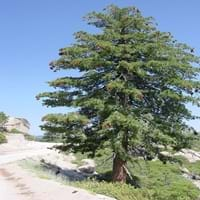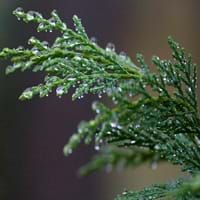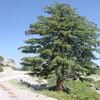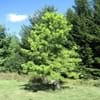Life Span
Perennial
Perennial
Type
Needled or Scaled Evergreen
Needled or Scaled Evergreen
Origin
Western United States, Canada
Hybrid origin
Types
Not Available
not available
Habitat
Woodland Garden Canopy
All sorts of environments, Alpine Meadows, High elevation, Hilly upland habitat
USDA Hardiness Zone
Not Available
6-9
Sunset Zone
Not Available
3b, 4, 5, 6, 7, 8, 9, 10, 11, 12, 13, 14, 15, 16, 17, 18, 19, 20, 21, 22, 23, 24
Habit
Oval or Rounded
Pyramidal
Flower Color
Non Flowering Plant
Non Flowering Plant
Flower Color Modifier
Bicolor
Bicolor
Fruit Color
Brown, Sandy Brown
Brown
Leaf Color in Spring
Not Available
Green, Blue Green, Gray Green
Leaf Color in Summer
Not Available
Green, Blue Green, Gray Green
Leaf Color in Fall
Not Available
Green, Blue Green, Gray Green
Leaf Color in Winter
Not Available
Green, Blue Green, Gray Green
Leaf Shape
Needle like
needle shaped
Plant Season
Spring, Summer, Fall, Winter
Spring, Summer, Fall, Winter
Sunlight
Full Sun
Full Sun
Type of Soil
Loam
Clay, Loam
The pH of Soil
Acidic, Neutral
Acidic, Neutral, Alkaline
Soil Drainage
Well drained
Well drained
Bloom Time
Not Available
All year
Tolerances
Drought
Cold climate, Deer resistant
Where to Plant?
Ground
Ground
How to Plant?
Cuttings, Seedlings
Hardwood Cuttings, Transplanting
Plant Maintenance
Medium
Medium
Watering Requirements
Water three times weekly in summer
Average Water Needs
In Summer
Lots of watering
Lots of watering
In Spring
Moderate
Moderate
In Winter
Average Water
Average Water
Soil pH
Acidic, Neutral
Acidic, Neutral, Alkaline
Soil Type
Loam
Clay, Loam
Soil Drainage Capacity
Well drained
Well drained
Sun Exposure
Full Sun
Full Sun
Pruning
Remove damaged leaves, Remove dead branches, Remove dead leaves
Prune for size control, Prune if you want to improve plant shape, pruning needed for strong structure, Remove damaged leaves, Remove dead branches, Remove dead leaves
Fertilizers
27-3-3 ratio, Requires high amount of nitrogen
All-Purpose Liquid Fertilizer, slow-release fertilizers
Pests and Diseases
Blister Rust
Canker, Root rot, Stigmina needle blight
Plant Tolerance
Drought
Cold climate, Deer resistant
Flower Petal Number
Single
Single
Foliage Texture
Not Available
Fine
Foliage Sheen
Glossy
Matte
Attracts
Douglas squirrels, Owls
Birds
Allergy
Skin irritation
Unknown
Aesthetic Uses
Not Used For Aesthetic Purpose
Formal Garden, Ornamental use, Showy Purposes, Woodland margins
Beauty Benefits
Not Available
Not Available
Environmental Uses
Air purification
Air purification
Medicinal Uses
Carminative, Laxative, Opthalmic, Poultice
No Medicinal Use
Part of Plant Used
Seeds, Wood
Not Available
Other Uses
Adhesive, Used as a chewing gum, Used for making green dye, Vanillin flavouring is obtained as a by-product
Acts as a natural source of rain water for birds and insects., deer resistant, Used as Christmas Tree
Used As Indoor Plant
No
No
Used As Outdoor Plant
Yes
Yes
Garden Design
Feature Plant
Feature Plant, Hedges, Mixed Border, Screening, Wind Break
Botanical Name
PINUS lambertiana
X CUPRESSOCYPARIS leylandii
Common Name
Sugar pine, Sugar cone pine
Leylandii
In Hindi
Sugar Pine
Leyland cypress
In German
Sugar Pine
Leyland-Zypresse
In French
Sugar Pine
Cyprès de Leyland
In Spanish
Sugar Pine
Cupressus leylandii
In Greek
Sugar Pine
Leyland Cypress
In Portuguese
Sugar Pine
Cipreste-de-leyland
In Polish
Sugar Pine
Cyprysowiec Leylanda
In Latin
Pinus
Leyland Cypress
Phylum
Coniferophyta
Coniferophyta
Class
Pinopsida
Pinopsida
Family
Pinaceae
Cupressaceae
Clade
Not Available
Not Available
Tribe
Not Available
Not Available
Subfamily
Pinoideae
Not Available
Number of Species
Not Available
Not Available
Season and Care of Sugar Pine and Leyland Cypress
Season and care of Sugar Pine and Leyland Cypress is important to know. While considering everything about Sugar Pine and Leyland Cypress Care, growing season is an essential factor. Sugar Pine season is Spring, Summer, Fall and Winter and Leyland Cypress season is Spring, Summer, Fall and Winter. The type of soil for Sugar Pine is Loam and for Leyland Cypress is Clay, Loam while the PH of soil for Sugar Pine is Acidic, Neutral and for Leyland Cypress is Acidic, Neutral, Alkaline.
Sugar Pine and Leyland Cypress Physical Information
Sugar Pine and Leyland Cypress physical information is very important for comparison. Sugar Pine height is 1,520.00 cm and width 760.00 cm whereas Leyland Cypress height is 1,830.00 cm and width 240.00 cm. The color specification of Sugar Pine and Leyland Cypress are as follows:
Sugar Pine flower color: Non Flowering Plant
Sugar Pine leaf color: Not Available
Leyland Cypress flower color: Non Flowering Plant
- Leyland Cypress leaf color: Green, Blue Green and Gray Green
Care of Sugar Pine and Leyland Cypress
Care of Sugar Pine and Leyland Cypress include pruning, fertilizers, watering etc. Sugar Pine pruning is done Remove damaged leaves, Remove dead branches and Remove dead leaves and Leyland Cypress pruning is done Prune for size control, Prune if you want to improve plant shape, pruning needed for strong structure, Remove damaged leaves, Remove dead branches and Remove dead leaves. In summer Sugar Pine needs Lots of watering and in winter, it needs Average Water. Whereas, in summer Leyland Cypress needs Lots of watering and in winter, it needs Average Water.





